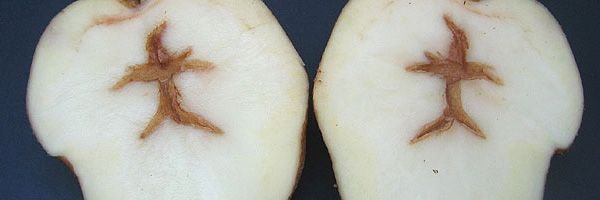
Brown heart and hollow heart
- Symptoms
Brown heart starts with a brown necrotic spot inside the pith of the tuber. When very extensive, it affects virtually the entire tissue and a crack forms in its centre. However, the tissues do not always crack and it may simply remain as a brown spot (photos 1 and 2).
Hollow heart manifests itself by a longitudinal cavity usually around the centre of the pith and sometimes situated near the rose-end or the heel-end. It is sometimes cross-shaped but its shape can also be irregular and take up almost the entire volume of the pith. The walls of the cavity become brown due to the formation of healing cork (photos 3 to 5).
With some susceptible cultivars such as BF 15 and Russet Burbank, hollow heart is preceded by brown heart; in others, it appears alone. That is why it is likely that these different symptoms are only the varietal expression of a single physiological disorder, especially as their causes are the same.
- Risk factors
The first disorders, which appear very soon after the tubers have been formed, are revealed by the destruction of a number of pith cells. The factors involved may be low temperatures (7 consecutive days with a daytime temperature below 15°C) and high relative humidity (80-85%) during this period.
Hollow heart usually appears in the centre of large tubers. In conditions of slow and regular growth, necrosis normally develops very little and remains at the brown heart stage, whereas in adverse conditions the tubers enlarge too rapidly causing the medullary (pith) tissue to rupture.
- Control
All factors that favour the rapid enlargement of the tubers can lead to the appearance of this defect in a susceptible cultivar: large quantities of water, excessive nitrogen and low planting density.
In high-risk areas, the following precautions should be taken:
- avoid susceptible cultivars such as Russet Burbank, BF 15, Béa, Désirée, etc.; o do not plant too early, especially if the spring is cold and wet;
- use moderate fertilisation;
- ensure a good tuber initiation by keeping the soil moist during this phase.





